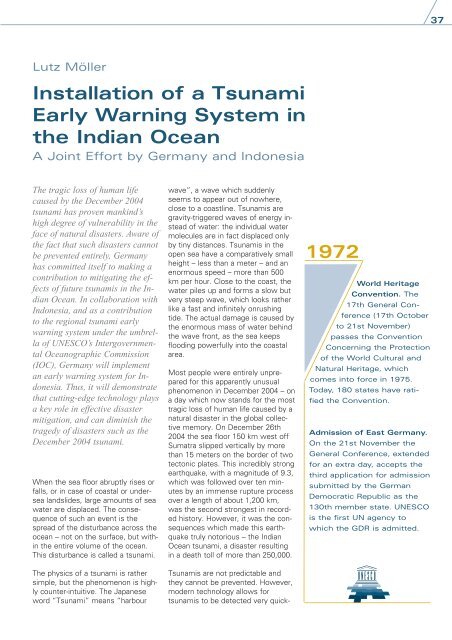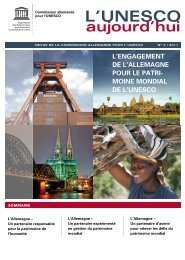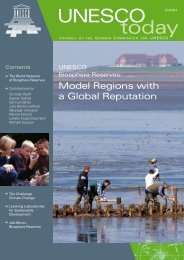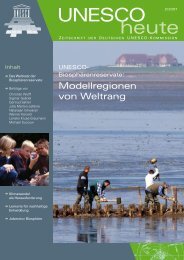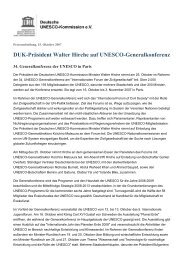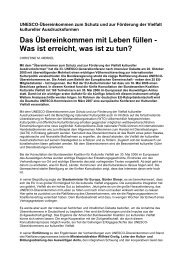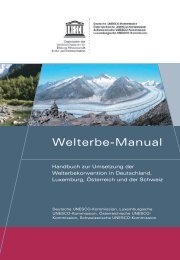Download - UNESCO Deutschland
Download - UNESCO Deutschland
Download - UNESCO Deutschland
You also want an ePaper? Increase the reach of your titles
YUMPU automatically turns print PDFs into web optimized ePapers that Google loves.
Lutz Möller<br />
Installation of a Tsunami<br />
Early Warning System in<br />
the Indian Ocean<br />
A Joint Effort by Germany and Indonesia<br />
The tragic loss of human life<br />
caused by the December 2004<br />
tsunami has proven mankind’s<br />
high degree of vulnerability in the<br />
face of natural disasters. Aware of<br />
the fact that such disasters cannot<br />
be prevented entirely, Germany<br />
has committed itself to making a<br />
contribution to mitigating the effects<br />
of future tsunamis in the Indian<br />
Ocean. In collaboration with<br />
Indonesia, and as a contribution<br />
to the regional tsunami early<br />
warning system under the umbrella<br />
of <strong>UNESCO</strong>’s Intergovernmental<br />
Oceanographic Commission<br />
(IOC), Germany will implement<br />
an early warning system for Indonesia.<br />
Thus, it will demonstrate<br />
that cutting-edge technology plays<br />
a key role in effective disaster<br />
mitigation, and can diminish the<br />
tragedy of disasters such as the<br />
December 2004 tsunami.<br />
When the sea floor abruptly rises or<br />
falls, or in case of coastal or undersea<br />
landslides, large amounts of sea<br />
water are displaced. The consequence<br />
of such an event is the<br />
spread of the disturbance across the<br />
ocean – not on the surface, but within<br />
the entire volume of the ocean.<br />
This disturbance is called a tsunami.<br />
The physics of a tsunami is rather<br />
simple, but the phenomenon is highly<br />
counter-intuitive. The Japanese<br />
word “Tsunami” means “harbour<br />
wave”, a wave which suddenly<br />
seems to appear out of nowhere,<br />
close to a coastline. Tsunamis are<br />
gravity-triggered waves of energy instead<br />
of water: the individual water<br />
molecules are in fact displaced only<br />
by tiny distances. Tsunamis in the<br />
open sea have a comparatively small<br />
height – less than a meter – and an<br />
enormous speed – more than 500<br />
km per hour. Close to the coast, the<br />
water piles up and forms a slow but<br />
very steep wave, which looks rather<br />
like a fast and infinitely onrushing<br />
tide. The actual damage is caused by<br />
the enormous mass of water behind<br />
the wave front, as the sea keeps<br />
flooding powerfully into the coastal<br />
area.<br />
Most people were entirely unprepared<br />
for this apparently unusual<br />
phenomenon in December 2004 – on<br />
a day which now stands for the most<br />
tragic loss of human life caused by a<br />
natural disaster in the global collective<br />
memory. On December 26th<br />
2004 the sea floor 150 km west off<br />
Sumatra slipped vertically by more<br />
than 15 meters on the border of two<br />
tectonic plates. This incredibly strong<br />
earthquake, with a magnitude of 9.3,<br />
which was followed over ten minutes<br />
by an immense rupture process<br />
over a length of about 1,200 km,<br />
was the second strongest in recorded<br />
history. However, it was the consequences<br />
which made this earthquake<br />
truly notorious – the Indian<br />
Ocean tsunami, a disaster resulting<br />
in a death toll of more than 250,000.<br />
Tsunamis are not predictable and<br />
they cannot be prevented. However,<br />
modern technology allows for<br />
tsunamis to be detected very quick-<br />
1972<br />
World Heritage<br />
Convention. The<br />
17th General Conference<br />
(17th October<br />
to 21st November)<br />
passes the Convention<br />
Concerning the Protection<br />
of the World Cultural and<br />
Natural Heritage, which<br />
comes into force in 1975.<br />
Today, 180 states have ratified<br />
the Convention.<br />
Admission of East Germany.<br />
On the 21st November the<br />
General Conference, extended<br />
for an extra day, accepts the<br />
third application for admission<br />
submitted by the German<br />
Democratic Republic as the<br />
130th member state. <strong>UNESCO</strong><br />
is the first UN agency to<br />
which the GDR is admitted.<br />
37


